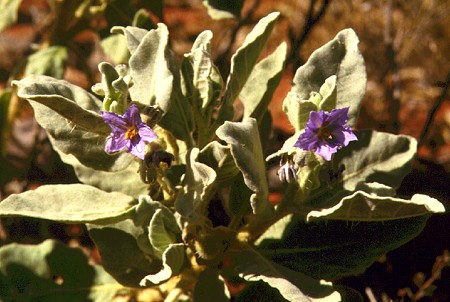
Synonymy
Solanum lasiophyllum Dunal ex Poiret, Encycl. Suppl. 3: 764 (1814) S. eriophyllum Dunal, Solan. Syn. 30 (1916), nom. illeg., based on S. lasiophyllum Dunal ex Poiret.
T: Shark Bay, W.A., coll. unknown; lecto: P; iso: K, P; fide D.E. Symon, J. Adelaide Bot. Gard. 4: 219 (1981).
S. lasiophyllum var. crassissimum Benth., Fl. Austral. 4: 463 (1868); S. crassissimum (Benth.) Domin, Biblioth. Bot. 89: 587 (1929).
T: Northern Australia, NW Coast, Bynoe s.n.; holo: K.
S. inceanum Domin, Vestn. Král. Ceské Spolecn. Nauk, Tr. Mat.- Prír. 22: 107 (1923). T: W.A., W.H. Ince s.n.; holo: PR 530926; iso: K.
Description
Erect or rounded shrub to 2 m, usually grey-green, the growing points and buds often purplish, densely pubescent with stellate hairs; prickles to 5 mm long, moderately abundant on stems and fruiting calyx, less common or absent elsewhere.
Leaves ovate to broadly elliptic; lamina mostly 4–7 cm long, 2.5–5 cm wide, sometimes larger, concolorous, entire, rarely shallowly lobed; petiole mostly 5–15 mm long.
Inflorescence short, the axis elongated in fruit, 2–7–flowered; peduncle 10–15 mm long; pedicels 8–10 mm long. Calyx usually 7–10 mm long; lobes triangular, 3–6 mm long; tube enlarged in fruit. Corolla rotate-pentagonal, usually 25–30 mm diam., purple. Anthers 4–6 mm long.
Berry globular to ovoid, rarely conical or ellipsoid, 10–15 mm diam., yellow; fruiting peduncle and axis to 9 cm long; fruiting calyx 10–15 mm diam. Seeds 2–3 mm long, pale or light brown. n=12, 24.
Distribution and ecology
Widespread in W.A., extending to south-western N.T. and central S.A. Outliers on the AVH generated map above represent introduced plants (Qld, ?WA), or probably wrongly recorded localities (SA). Bean (2004) noted a non-persisting occurrence near Bundaberg in 1981.
Usually occurs in sand or on stony rises in W.A., but restricted to rocky outcrops and ranges in N.T. and S.A.
Common name
Flannel Bush
Relationships
Considered by Bean (2004) to be a member of the S. lasiophyllum group of subgen. Leptostemonum.
Notes
Used as a medicinal plant by Aborigines in W.A.
Seedling description: Cotyledons lanceolate, glandular-ciliate, c. 18 mm long and 5 mm wide. The first leaves are ovate-elliptic, glandular hairy and 12 mm long and 7 mm wide.
Selected specimens
W.A.: About 12 km E of Carnegie, J.S. Beard 4812 (PERTH). N.T.: c. 180 km W of Ayers Rock, J.R. Maconochie 659 (NT). S.A.: near Mt Davies, 24 Aug. 1954, J.B. Cleland (AD); Mt Christie, D.E. Symon 3387 (AD).
Plant status, if any
Conservation status as a Data Deficient plant in the
From the web
Further information and images of S. lasiophyllum can be seen on the FloraBase site and a fact sheet can be downloaded from the SA eFlora site.
Links to images of S. incanum (photos and herbarium specimens) can be seen on the Radboud University, Nijmegen (Netherlands) site. Another image can be seen at www.anbg.gov.au/photo/apii/id/dig/1740
Limited information, but images of specimens, can be found on the Solanaceae Source site.




